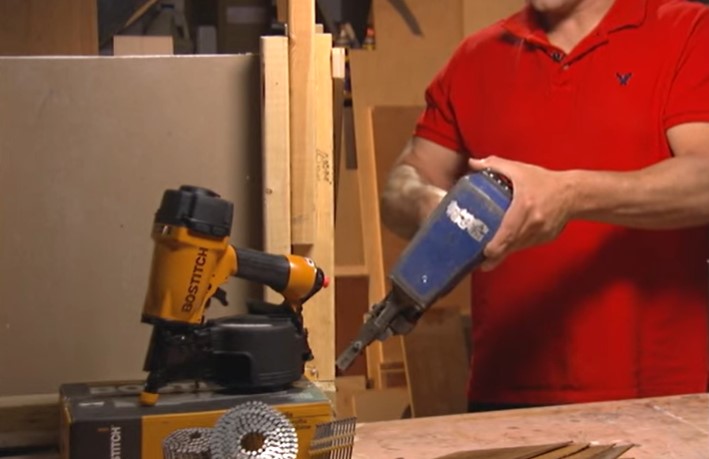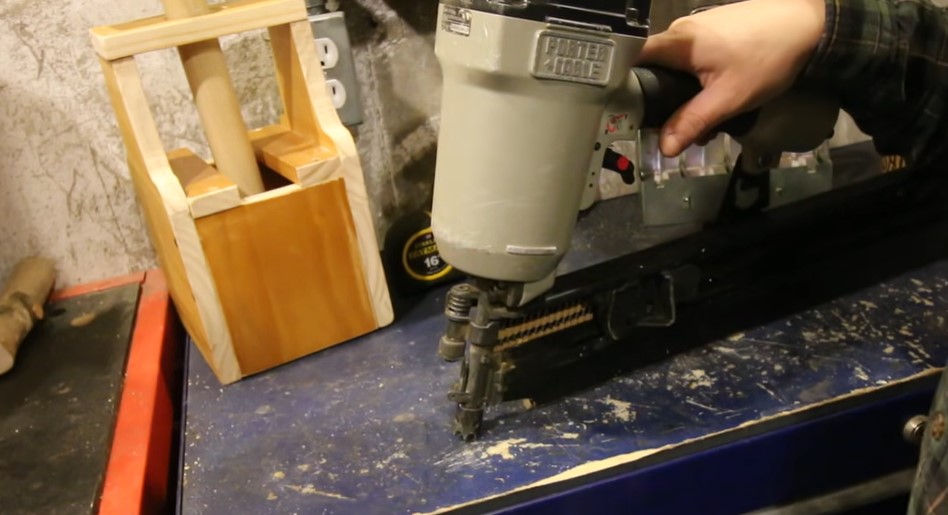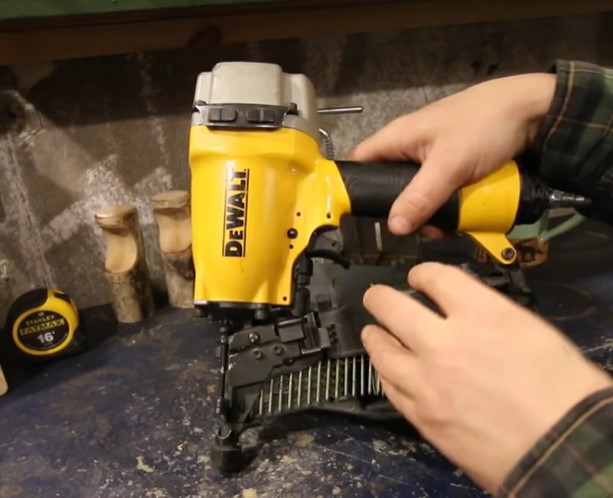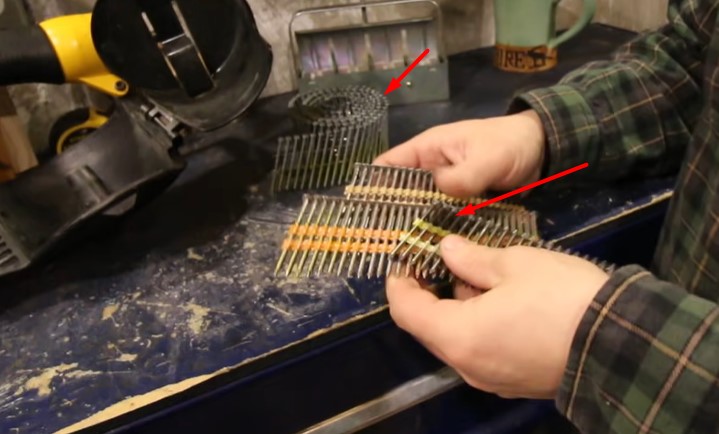Hello there, passionate craftsmen and inquisitive minds! Today, buckle up for an exhilarating adventure into the pulsating world of nailers, where the mighty framing nailer clashes with the daring roofing nailer in a nail-biting showdown of epic proportions.
Crafting excellence demands the perfect tools, and in the realm of carpentry, framing nailers and roofing nailers stand as indispensable titans. While these two tools may seem akin, a closer look reveals their distinct personalities and specialized features tailored for specific tasks.
Join us on a captivating journey through the nuances that set framing and roofing nailers apart, empowering you to make an enlightened choice for your woodworking endeavors.

Framing Nailer Unleashed: Power Packed Punch!
Picture this: You want to build a fort, a treehouse, or maybe a secret hideout. The framing nailer swoops in like a hero, driving nails with the force of a thousand hammers. Bam, bam, bam – your dream structure takes shape!
A framing nailer is a powerful tool designed for heavy-duty tasks in construction. It is specifically crafted for framing large structures, such as walls and floors, providing efficiency and precision in attaching framing elements together.

Roofing Nailer: The High-Flyer
Now, imagine your house needs a superhero to keep the rain away. The Roofing Nailer is here to save the day! It zooms across your roof, attaching shingles faster than a squirrel collecting nuts. Raindrops, meet your match!
Roofing nailers are tailored specifically for roofing applications. They are designed to handle shingles and other roofing materials efficiently.

How They Work: Let’s Talk Like Bob the Builder
Bob the Builder says, “Can we nail it? Yes, we can!” These tools are like Bob’s friends, helping him build cool stuff. They work by shooting nails at lightning speed, making sure everything sticks together – just like magic!
A framing or roofing nailer operates by utilizing compressed air or gas to drive nails into wood or other materials. These powerful tools feature a magazine that holds a strip of nails, typically connected with paper or wire. When the trigger is pulled, the nailer releases a piston that rapidly pushes a nail from the magazine into the material.
The force generated by the compressed air or gas ensures precise and efficient placement of nails, making it an essential tool in framing, roofing, and carpentry for quick and sturdy construction.
It’s like making a sandwich. You have bread (your building materials), and the nailer is the superhero spreading peanut butter (nails) to hold everything in place. Easy peasy, right?
Strength Face-off: Framing vs Roofing
Hulk’s Hammer vs Superman’s Shingle Shooter
Framing Nailer is like the Hulk – strong and robust, perfect for heavy-duty tasks. It allows you to drive large and heavy-gauge nails into tough materials effortlessly.
Roofing Nailer? It’s Superman, soaring high and precise, dealing with shingles like a superhero tackling villains. They focus more on precision and control, ensuring that nails are securely fastened without damaging delicate roofing materials.
The Size Matters: Framing vs Roofing
Nails for Framing Nailers: Framing nailers typically use larger, thicker nails suitable for framing structures. Common nail types include common nails and box nails.
Roofing Nailer Nail Considerations: Roofing nailers work with smaller, thinner nails, often featuring galvanized coatings to resist corrosion and ensure longevity.

The Portability and Design: Which is More Convenient?
Framing Nailer Designs: Framing nailers are generally bulkier and heavier due to their powerful mechanisms, emphasizing stability and durability.
Roofing Nailer Portability: Roofing nailers are designed with portability in mind, often featuring a more lightweight and compact design for ease of use on elevated surfaces.
Framing Nailer vs Roofing Nailer Functionality
When to Call in the Framing Brigade?
When you’re constructing big, strong things – like a fortress or a deck – that’s when you dial up the Framing Nailer Brigade. It’s a powerhouse for your heavy-duty dreams!
Calling on the Roofing Heroes
When rain threatens to sneak into your cozy abode, it’s time to summon the Roofing Heroes. They zip through the rooftops, securing shingles and ensuring your home stays dry and happy.
Cost Check: Framing vs Roofing
Now, let’s talk about something important – money! Framing nailer might cost a bit more, like buying extra cookies for a special treat. The roofing nailer is your practical friend, saving you a few jars for later.
Framing Nailer Vs Roofing Nailer: Real-life Adventures
| Features | Framing Nailer | Roofing Nailer |
|---|---|---|
| Primary Use | Framing large wooden structures | Installing shingles and roofing |
| Nail Size | Longer nails (2 to 3.5 inches) | Shorter nails (3/4 to 1.75 inches) |
| Magazine Capacity | Larger capacity | Smaller capacity |
| Angle of Nails | Typically 21 degrees | Typically 15 degrees |
| Weight | Heavier | Lighter |
| Depth Adjustment | Adjustable for various materials | Often preset for roofing materials |
| Collation Type | Full-round or clipped-head nails | Coil or strip nails |
| Application | Framing, sheathing, decking, etc. | Roofing, siding, and insulation |
| Power Source | Pneumatic or cordless | Pneumatic or cordless |
| Special Features | Depth adjustment, selective actuation | Quick reloading, durability |
| Pros | – Suitable for heavy-duty construction – Versatile in handling various materials – Powerful and efficient | – Heavier and bulkier – Higher cost |
| Cons | – Lightweight and portable – Ideal for roofing applications – Budget-friendly | – Limited application to roofing projects – Less powerful than framing nailers |
Can You Use A Framing Nailer For Roofing?
While it’s technically possible to use a framing nailer for roofing, it’s not recommended. Framing nailers are designed for heavier-duty tasks like framing large structures, and their longer nails and different angles may not provide the optimal results for roofing applications.
It’s generally more efficient and effective to use a dedicated roofing nailer specifically designed for installing shingles and roofing materials.
Which One is Right for You?
Are you building a fortress or protecting against raindrops? Pick your superhero accordingly. Framing nailer for the heavy-duty champs, roofing nailer for the rooftop defenders.
Pros’ Perspective: What Experts Say
Experts agree – both nailers are rock stars in their own domains. It’s not about choosing the best; it’s about picking the one that suits your construction quest. Listen to the wise ones, young builders!
Framing And Roofing Nailer Combo
A framing and roofing nailer combo is a set of two air-powered tools specifically designed for driving nails into wood for framing and roofing applications. They are typically sold together as a kit and are a valuable asset for professionals and DIYers alike.
Benefits of a combo kit:
- Convenience: Having both tools in one kit eliminates the need to purchase and store them separately.
- Cost-effectiveness: Combo kits are often cheaper than buying the tools individually.
- Versatility: You’ll be equipped for both framing and roofing projects.
Here are some popular framing and roofing nailer combo kits:
DeWalt DW325PL & DW45RN: A professional-grade combo kit with a framing nailer that can handle nails up to 3-1/2″ and a roofing nailer that can handle nails up to 1-3/4″.
Porter-Cable FR350B & RN175C: A good value combo kit with a framing nailer that can handle nails up to 3-1/2″ and a roofing nailer that can handle nails up to 1-3/4″.
Ridgid R350RHF & R175RNF: A high-end combo kit with a framing nailer that can handle nails up to 3-1/2″ and a roofing nailer that can handle nails up to 1-3/4″.
Conclusion
In this epic battle of framing nailer vs roofing nailer, there’s no loser – only winners crafting dreams and protecting homes. So, which side are you on? The heavy-duty builders or the raindrop defenders? Embrace your superhero tool and let the construction adventure begin!
FAQs: Your Most Asked Queries
Can a framing nailer be used for roofing?
While it’s possible, it’s not recommended. Framing nailers are designed for heavy-duty tasks and may damage delicate roofing materials.
Are roofing nailers suitable for framing?
Roofing nailers lack the power needed for framing large structures effectively, making them less suitable for such tasks.
What safety precautions should be taken when using nailers?
Always wear appropriate safety gear, including eye protection. Follow the manufacturer’s guidelines for usage and maintenance.
Can I use different nail types in the same nailer?
It’s essential to use the recommended nail types for each nailer to ensure optimal performance and safety.
Are there any specific brands recommended for framing or roofing nailers?
Popular brands like DeWalt, Bostitch, and Hitachi are known for producing reliable framing and roofing nailers.
Recent Posts
Woodworking in 2025 is all about efficiency, precision, and smart technology. Whether you're a beginner or a seasoned craftsman, having the right tools can make all the difference. Here are the top 7...
Ever tried drilling into a piece of wood only to end up with a splintered mess or a wobbly hole? Yeah, it's more common than you think. Wood might seem like an easy material to work with, but...

